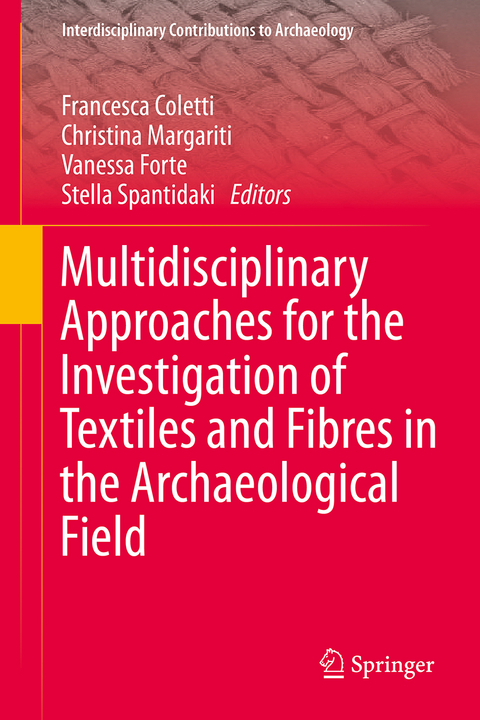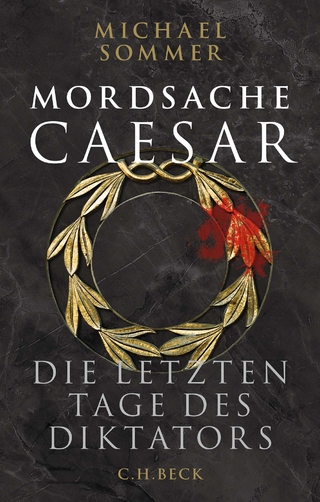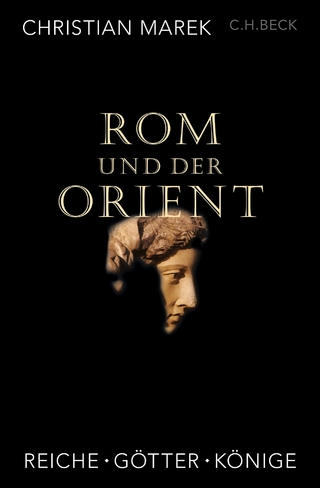
Multidisciplinary Approaches for the Investigation of Textiles and Fibres in the Archaeological Field
Springer International Publishing (Verlag)
978-3-031-73811-1 (ISBN)
This book is dedicated to the analytical methods and approaches applied to ancient textiles and fibres. It offers an overview of textile archaeology as an archaeological discipline, presenting its history and developments up to state of the art approaches in the study of textiles fibres. It demonstrates how various fields of research have contributed to the development and growth of the discipline.
It establishes that fibre identification is a key element in ancient textile studies, showing its importance in understanding a large variety of economic and social aspects of human societies. However, fibre identification in archaeological textiles is not a straightforward task, mainly due to the vast variety of fibres people used in antiquity to make textiles and the more often than not poor condition of preservation of excavated textiles. Currently, comprehensive studies on more traditional fibre identification techniques, such as Scanning Electron and Optical microscopy, spectroscopic techniques (e.g. Fourier Transform Infrared spectroscopy - FTIR, Raman) and recent advances in DNA and paleoproteomics, along with experiments on artificial ageing and deterioration of textiles, constitute a promising path down the exploration and analysis of archaeological textiles. This book shows how these techniques have advanced the discipline of textile archaeology and contributed to our understanding of the past.
This volume brings together scholars investigating fibres in a holistic way, by the incorporation of a variety of methods, in order to improve the current methodological approaches in the study and conservation of textiles and related material.
Chapter 6 is available open access under a Creative Commons Attribution 4.0 International License via link.springer.com.
Francesca Coletti is a classical archaeologist specialised in textile and fiber analysis. She is a research fellow at Sapienza University of Rome with the project “Archaeology, Archaeometry, and Digitalisation of Archaeological Textiles from Herculaneum” (position obtained thanks to the European Seal of Excellence 2023). Since 2018, she has taught the “Archaeology and Archaeometry of Textiles” course at Sapienza University, and she has been involved in several interdisciplinary projects focused on textiles from Greece, Italy, and Turkey. In 2020, she received her PhD, in co-tutorship at Heidelberg and Sapienza Universities, with the thesis “The Textiles of Pompeii: Materials, Techniques and Contexts”, investigating the fabrics and textile imprints on human plaster casts. Her research is part of the project “Textile Culture in Pompeii” in cooperation with the Archaeological Park, with which she collaborates to study and recover fabrics found during the new excavations. Thanks to recent national and international grants, Coletti is currently engaged in two collaborative research projects in the framework of the interdepartmental research centre at Sapienza “A3TEX. Archaeology and Archaeometry of Ancient Textile”: TEXTaiLES (HORIZON-CL2-2023-HERITAGE-ECCCH-01-02, Innovative Tools for Digitising Cultural Heritage) and ADigText (“Archaeology, Archaeometry and Digitalisation of Ancient Textile. From Pompeii to the Roman Empire”) (PRIN 2022. PI Prof. M. Galli, Co-PI Prof. M. Gleba). Christina Margariti trained as textile conservator, MA in Textile Conservation, at the Textile Conservation Centre/University of Southampton, where she also completed her PhD on the analysis of excavated textiles. She was a MSCA Fellow at the University of Copenhagen (project FIBRANET). She is the Head of the Applied Research Department of the Directorate of Conservation/ Hellenic Ministry of Culture and has taught textile conservation and analysis at the Technological Educational Institute of Athens, and the Centre for Textile Research/SAXO Institute, University of Copenhagen. Vanessa Forte is a prehistoric archaeologist at Sapienza University of Rome, specialising in ancient technology and use-wear analysis on ceramics and clay objects. After earning her Ph.D. from Sapienza University, she was a Marie Skłodowska-Curie Fellow at the McDonald Institute for Archaeological Research at Cambridge University (UK), focusing on craft specialisation. She later worked as a postdoctoral researcher at the Universities of Pisa and Padova, collaborating with international research groups. She integrates archaeometric analyses, technological traces, use-wear studies, and experimental archaeology to reconstruct and investigate the socio-cultural dynamics of ancient societies. Stella Spantidaki is a Classical archaeologist specialised in textile archaeology of ancient Greece. In her PhD, conducted at the Universities of the Sorbonne and the Heidelberg University, she focused in textile production in Classical Athens. In her research, she uses interdisciplinary methodology and studies all available sources for textile production and consumption in antiquity. Since 2015 she is the Director of ARTEX, a research centre in Athens specialising in the study and scientific analyses of archaeological textiles. Currently she is the PI in the Project FAROS, “The Fabric of Kings: Funerary Textiles from Mycenae and the early Mycenaean textile production”, hosted at the University of the Peloponnese and funded by the Hellenic Foundation for Research and Innovation (HFRI, pr. no. 7354, 2023-2025).
Chapter 1. Introduction - Towards multidisciplinary trajectories for the study of ancient textiles and fibres (Francesca Coletti, Vanessa Forte, Christina Margariti and Stella Spantidaki).- Chapter 2. Using Scanning Electron Microscopy for the Study of Mineralised Textiles: The Case of Roman Venetia (Margarita Gleba and Maria Stella Busana).- Chapter 3. A button, a hook and a rug paper wrapping - Identifying plant fibre finds from Hailuoto, Finland (Jenni A. Suomela and Sanna Lipkin).- Chapter 4. The effects of carbonisation on the morphology of textile fibres. Comparison between modern and ancient materials: The example of Pompeii (Francesca Coletti and Christina Margariti).- Chapter 5. Multi-analytical approach for the characterisation of ancient mineral fibres. Tracing the use of asbestos in the Italic Peninsula (Francesca Coletti, Alessandro Ciccola and Paolo Postorino).- Chapter 6. Revealing the unknown: how multi-technical approach can be crucial in identification of dyes and protein in archeological remains (Ilaria Serafini, Alessandro Ciccola, Roberta Curini, Gabriele Favero, Gwénaëlle M. Kavich, Timothy P. Cleland and Caroline Solazzo).- Chapter 7. Radiocarbon for the dating of fibres and textiles: the case study of a silk double knitted fabric from Pompeii (Mariaelena Fedi, Serena Barone, Francesca Coletti and Lucia Liccioli).- Chapter 8. Which tool for which fiber? Experimental spinning tests using bone, glass and amber instruments (Maria Stella Busana, Denis Francisci and Agnese Lena).- Chapter 9. Residues of activities: towards an analytical protocol for studying residues on textile tools (Vanessa Forte, Francesca Coletti, Carlo Virili, Alessandro M. Jaia and Cristina Lemorini).- Chapter 10. Resolving the mystery of the 2000-year-old net found in the "Cave of Letters" (Reuven Yosef, Lee Perry-Gal and Naama Sukenik).- Index.
| Erscheinungsdatum | 18.11.2024 |
|---|---|
| Reihe/Serie | Interdisciplinary Contributions to Archaeology |
| Zusatzinfo | VIII, 189 p. 64 illus., 52 illus. in color. |
| Verlagsort | Cham |
| Sprache | englisch |
| Maße | 155 x 235 mm |
| Themenwelt | Kunst / Musik / Theater |
| Geisteswissenschaften ► Archäologie | |
| Geschichte ► Allgemeine Geschichte ► Altertum / Antike | |
| Geisteswissenschaften ► Geschichte ► Hilfswissenschaften | |
| Sozialwissenschaften | |
| Schlagworte | Analytical Methods ancient textiles fibres • Archaeometry textile archaeology • Asbestos fibres from Pompeii by morphological analysis • Carbonisation to the morphology of textile fibres • Challenges fibre identification textile imprints clay sealings • Excavated Textiles • Experimental Archaeology textiles • Experimental spinning tests bone, glass and amber instruments • Female textile funerary equipment • Mass spectrometry identification dyes and protein • Microspectrofluorimetry natural dyes in textiles • Organic Residues archaeology identification • Plant fibre identification electron microscopy techniques • Scanning Electron Microscopy Mineralised Textiles • Textile Archaeology • Textile archaeology Bronze Age Greece • Textile Conservation |
| ISBN-10 | 3-031-73811-X / 303173811X |
| ISBN-13 | 978-3-031-73811-1 / 9783031738111 |
| Zustand | Neuware |
| Informationen gemäß Produktsicherheitsverordnung (GPSR) | |
| Haben Sie eine Frage zum Produkt? |
aus dem Bereich


